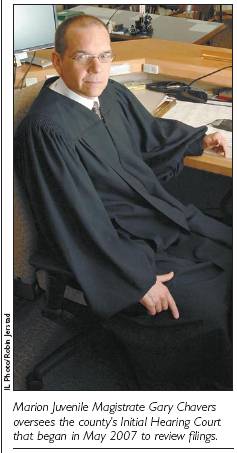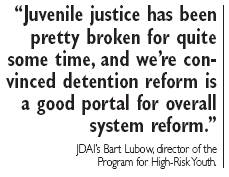Subscriber Benefit
As a subscriber you can listen to articles at work, in the car, or while you work out. Subscribe Now
One Hoosier juvenile court system has made significant strides to improve its juvenile justice in recent years, becoming
a nationally recognized court for innovative programs that other jurisdictions are encouraged to emulate.
Measures taken in the Marion Juvenile Court have had tangible consequences for the local and state system: a dramatic cut
in the number of youth detained pending trial, mandatory reviews of delinquency petitions that has led to an estimated 50
percent hike in the rate of counsel representation, and an overall environment change that juvenile advocates and attorneys
say makes the process less tenuous and more fair for everyone involved.
“We take kids’ rights very, very seriously,” Marion Juvenile Judge Marilyn Moores said. “A level
playing field is the basis for all justice. Period. That’s what we’ve been trying to ensure.”
Three years ago, the system in Marion County was quite different: Judge Moores had just taken over the court from Judge James
Payne, who’d been there for 22 years before being tapped to head the Indiana Department of Child Services. Children
flooded the system, and rules of due process were often bypassed as juveniles frequently waived their right to counsel before
ever consulting with a public defender. The detention center was declared unsafe and ridden by scandal after a federal probe
in 2006 and reports of sexual abuse and misconduct were lodged against staff. Often, the center was packed beyond its capacity
with youths crowded in cells.
Judge Moores took the bench in March 2005 and the Marion Superior Court’s Executive Committee- led at the time by then-presiding
Superior Judge Cale Bradford- overhauled the system and laid a foundation for the transformation that’s been playing
out since then.
The judge emphasized that her predecessor was instrumental in developing best practices in juvenile cases and cared deeply
about making the court the best it could be, though she admittedly operates differently and has delegated some responsibility-
such as the detention center operations- to those outside the juvenile court to improve efficiency.
“We were at a critical juncture,” Judge Moores said. “There was a big disconnect when I came here, but
everyone came together in an incredible partnership of our juvenile justice community. Now, we’re a model and an impetus
for additional reform of this system.”
To figure how to cut detention numbers and get at the root of the problem of why juveniles were in the system to begin with,
Judge Moores decided early on that she needed to revamp how her court operated.
Initial Hearing Court
One of the reforms Judge Moores made was turning to an old law, but looking at it in a new way to determine whether the court
could operate more efficiently. An answer came from Indiana Code 31-37-10-2, which allows a court to use a two-pronged approach
in determining whether a delinquency petition should be filed with the court.
 Rather than just focusing on probable cause as most juvenile courts do, Judge Moores put into place a mechanism
Rather than just focusing on probable cause as most juvenile courts do, Judge Moores put into place a mechanism
to utilize the second, less-used prong: even if probable cause exists, looking at whether a filing would be in the child’s
or public’s best interest.
In the Initial Hearing Court, the prosecutor’s office presents a petition for the court to determine whether it will
approve the filing and allow the case to proceed. Previously, five magistrates handled the initial hearings on dockets along
with trials, review hearings, and child welfare cases and each didn’t have much time to devote to considering the petition
outside of probable cause, Judge Moores said.
She turned to Magistrate Gary Chavers, who’d been the supervising attorney for the juvenile division of the Marion
County Prosecutor’s Office for 22 years, to help institute change and create an Initial Hearing Court that opened a
year ago. He is the sole magistrate concentrating on initial hearings for youth and serves as a “judicial gatekeeper”
for the juvenile court.
Eight sessions are held a week for delinquency cases, Magistrate Chavers said.
Since the court began in May 2007, about 550 petitions have been rejected, and many have been school-related offenses, records
show. During a six-month period ending Oct. 31, the court rejected 289 of 1,803 petitions filed for its approval- about 40
percent were school related. Although the court found probable cause, the magistrate didn’t find those filings would
be in the best interest. He notes that some petitions are ultimately dismissed before reaching his initial hearing court-
the prosecutor’s office rejects some, and others are put into pre-court diversion programs.
“It adds another layer of looking at whether it needs to go through the judicial process,” Magistrate Chavers
said.
He said the Initial Hearing Court examines a child’s history and family situation, and reviews the preliminary inquiry
by probation as well as the child’s juvenile record. By law, he’s able to take a case under advisement for 60
days to find out if a juvenile can go without any further problems before dismissing the case, the magistrate said.
“We’re trying not to criminalize these kids as much as possible and unnecessarily build up juvenile records,”
he said.
The Initial Hearing Court has enabled the entire juvenile court to become more efficient, Magistrate Chavers said. The first
four months of 2008 saw a 30 percent increase in the number of Child In Need of Services cases, he said, and the Initial Hearing
Court has enabled an extra CHINS session to be added to each of the four magistrates’ courtrooms. Previously, six detention
and two CHINS sessions were held each week; now five detention and three CHINS hearings are held, he said.
“I’m not sending those to trial in other courts, and that means they’ve got additional time,” Magistrate
Chavers said. “Overall, this has helped in court processing and allowed us to become more efficient.”
The court has also worked to change how juveniles use their right to counsel, Magistrate Chavers said. Every child put into
the juvenile detention center before an initial hearing gets to talk with a public defender before coming to court the following
day, he said. That public defender will determine whether the family wants to hire a private attorney or go ahead with a public
defender.
 “A very important decision is made at that initial hearing, which is also the initial detention hearing,” he
“A very important decision is made at that initial hearing, which is also the initial detention hearing,” he
said. “We let very few proceed without a public defender, and that’s a change in philosophy from the past few
years.”
Before allowing a child to waive their right to counsel, Magistrate Chavers said he makes sure that a probation form is signed
and understood, that he explains their rights in court, and that the parents understand that a public defender can be immediately
available and accommodate their schedules, he said. If any child or parent hesitates or has a juvenile record or felony offense,
then the magistrate said he always appoints an attorney.
The county has come a long way, but the magistrate said that some children still waive their right to counsel and the county
can’t catch every one. But he noted the General Assembly hasn’t made statewide changes- lawmakers failed to pass
a bill last year mandating that every child have an attorney appointed. He noted that Marion County is different than other
counties because it’s invested the money in recent years in indigent defense for juveniles and has its own juvenile
division, where many do not. During conversations with other Hoosier juvenile jurists at statewide conferences, Magistrate
Chavers said some have told him that their counties would go bankrupt if they were forced to pay for public defense for all
juveniles.
Detention alternatives
Through the Initial Hearing Court and its detention alternative programs, the Marion Juvenile Court has seen a significant
drop in the number of youth sent to its Juvenile Detention Center that has been plagued with problems. When Judge Moores took
over the court in 2005, the 144-bed center regularly topped that level and neared 200. Now, that number has dropped to the
high-80s to mid-90s, and the court’s been able to close two pod cells and cap the detainment number at 112.
The detention center population has dropped in large part to efforts adopted through the Annie E. Casey Foundation’s
Juvenile Detention Initiative, Judge Moores said. The court system has a three-year grant to pay for a Juvenile Detention
Alternatives Initiative (JDAI) coordinator and risk-assessment tool in studying juvenile detention issues.
Nationally, the JDAI promotes policy change and practices to reduce reliance on secure confinement, improve public safety,
and stimulate overall juvenile justice reforms. Indianapolis is the only Hoosier location of the JDAI’s 100 jurisdictions
in 22 states and Washington, D.C.
Indiana is viewed as a success that JDAI coordinators on the national level hope can be emulated in other jurisdictions.
“Juvenile justice has been pretty broken for quite some time, and we’re convinced detention reform is a good
portal for overall system reform,” said the JDAI’s Bart Lubow, director of the Program for High-Risk Youth. “This
is one innovation that’s an interesting and different idea. What’s so positive about Marion County is the perspective
of the leaders having the right attitude. They aren’t in this for the short term or under the mistaken impression that
you do a little and poof, everything’s better. It’s a far cry from where it was three or four years ago.”
Here, the Marion Juvenile Court has established a risk-assessment tool to reduce the number of juveniles being locked up.
The local initiative focuses on a day and evening reporting, curfew enhancements, home counseling, and programs for lower
offenses, according to Marion County’s JDAI coordinator Gael Deppert.
“We were locking up a lot of kids that didn’t present a risk to public safety,” Deppert said. “That
helps determine if you have the right kids in the juvenile detention center, and you’re not benefiting the most you
can from the system.”
Deppert said the hope is to get these children involved in programs enough so they’ll want to stay involved and stay
out of the juvenile justice system.
After the detention focus, the local JDAI will address CHINS cases, which lead to about 30 percent of the delinquency cases
ultimately coming before her court, Judge Moores said. About 10 CHINS cases are filed a day and, as of mid-April, about 100
more of these cases had been filed locally than in the same period last year, she said. The judge couldn’t explain the
increase, but said the JDAI initiative can help find solutions to better address those types of cases.
“We want to institute the elements for continual change,” Judge Moores said. “Best practices have to always
be evolving, otherwise we’ll be right back to where we started. We’re the early warning system for the entire
criminal justice system. So if we don’t stay on the cutting edge, we’re all in trouble.”
Please enable JavaScript to view this content.
